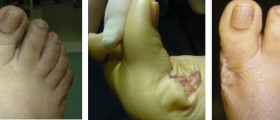Malignant hyperthermia is a rather rare and potentially lethal medical condition occurring once a person undergoes general anesthesia. The susceptible individuals are genetically predisposed to develop fever and uncontrollable muscle contractions once they are administered certain drugs used for general anesthesia. If left untreated, the condition also leads to inappropriate supply of all the body cells with oxygen, inadequate elimination of carbon dioxide and circulatory collapse, a common cause of lethal outcome.
Unfortunately, this genetic predisposition cannot be tested in any way, so only if the condition is confirmed in other family members a doctor may expect that it will occur in the patient himself/herself. Also, malignant hyperthermia is basically confirmed once it develops. Repeated exposure to general anesthesia, to be more precise to certain drugs used for this purpose, is strictly forbidden.

Classification
There is no special classification, since malignant hyperthermia is always associated with the same symptoms and signs. However, there are different names which describe the same condition. So, malignant hyperthermia is also referred to as malignant hyperthermia syndrome or malignant hyperpyrexia. What needs to be mentioned is that this medical condition may occur alone or together with multiminicore myopathy and central core disease.
Symptoms and Signs of Malignant Hyperthermia
All the symptoms and signs of malignant hyperthermia are actually connected with a hypercatabolic state, the one triggered by the intake of the drug the person is sensitive to. There is an increase in body temperature (extremely high body temperature to 105 degrees F or higher), increased heart rate and palpitations as well as increased breathing rate. Carbon dioxide is produced in large amounts, cannot be eliminated properly, while on the other hand, the body uses too much oxygen. As a result, the amount of oxygen becomes insufficient.
The above mentioned is closely related to a severe metabolic imbalance known as acidosis. The muscles become rigid. One may even develop rhabdomyolysis. Rhabdomyolysis is a serious condition characterized by the breakdown of muscle fibers. Damaged muscle cells release huge amount of myoglobin into the blood. The excess of this protein can cause damage to the kidneys and even make matters worse. The urine containing blood is dark brown while damage to muscles always triggers muscle ache similar to one we experience while exercising or when muscles are somehow injured.
Malignant hyperthermia may develop gradually within several hours after exposure to general anesthesia although it is in the majority of cases reported to occur soon after certain drugs are administered, approximately within one hour.
Prevention
The only way to prevent malignant hyperthermia is not to expose the patient to the drug he/she may be susceptible to. However, this is not always possible especially if one does not report any case of malignant hyperthermia in his/her family history. So, only once the person develops the condition, doctors can be sure that he/she is suffering from malignant hyperthermia and may prevent any repeated attack.
Medical experts used to administer dantrolene prophylactically in predisposed patients while these were administered general anesthesia. This drug was not confirmed to reduce the chance of the attack and, therefore, the practice of it being used in malignant hyperthermia susceptible patients was discontinued.
Since in the majority of cases malignant hyperthermia is practically triggered by volatile anesthetic gases like halothane, sevoflurane etc. or certain muscle relaxants , these medications are best to avoid. It is also essential to be fully prepared for potential attack and react promptly.
Additional precautionary measures include removal of vaporizers form the anesthetic machine, replacement of the breathing circuit and flushing the machine along with the ventilator with 100% oxygen.
If, in spite of all the mentioned measures condition occurs, doctors are due to act promptly and treat patients adequately. Patients are immediately administered dantrolene intravenously. Additional supportive measures bring hyperthermia, acidosis and organ dysfunction under control. The treatment must be aggressive because the condition leads to a set of imbalances, all of which require special care. Fortunately, unlike in the 1970s when the mortality rate was more than 80% today less than 5% of all patients die.
Relevant Data
- Brady et al. have estimated the malignant hyperthermia prevalence rate for the years 2001 to 2005 at 1.1/100,000 New York State surgical discharges with probable anesthetic exposures.
- However, Monnier et al. and Ibarra et al.'s analyses of individuals with homozygous or compound heterozygous mutations yielded an estimated malignant hyperthermia susceptibility prevalence as high as 1 in 2000 to 3000 in the French and Japanese populations.
- Recent mortality estimates have been disparate partially as a function of the characteristics of the database used for analysis. Li et al. recently estimated the risk of malignant hyperthermia-related mortality at 0.0082 per 100,000 United States surgical inpatients encompassing approximately 1% of all anesthesia-related deaths for the years 1999 to 2005.
- In contrast, Rosero et al.50 estimated the risk of malignant hyperthermia-related mortality at 0.1310 out of 100,000 United States inpatients. Li et al.'s lower estimate of malignant hyperthermia-related mortality is more likely than Rosero et al.'s because the latter study used a less rigorously collected administrative database and it did not isolate medical from surgical patients.
- Although malignant hyperthermia mortality rates are low, the rate of complications in acute malignant hyperthermia episodes is much higher. Larach et al. found a 34.8% morbidity rate in 181 cases reported to the North American Malignant Hyperthermia Registry of Malignant Hyperthermia Association of the United States between 1987 and 2006.
- Frequently reported complications included change in consciousness level/coma, cardiac dysfunction, pulmonary edema, renal dysfunction, disseminated intravascular coagulation, and hepatic dysfunction.
- The high complication rate emphasizes the need to continue to educate practitioners on the most effective way to diagnose and treat malignant hyperthermia events and to study whether these efforts subsequently decrease the morbidity rate.
It is estimated that the incidence malignant hyperthermia varies and may occur in 1 out of 5,000 to 1 out of 50,000-100,000 procedures performed under general anesthesia.
The condition is reported in every country in the world, affecting people of all ethnic groups equally. There is only age difference since malignant hyperthermia predominantly occurs in children and young individuals.
As far as history is concerned, the condition was first identified in one family from Australia in 1962. Until then scientists have managed to identify the genes that may be blamed for increased susceptibility to general anesthesia i.e. certain drugs used in this purpose.
What is more, they have also succeeded in saving lives of people who experience this condition and preventing further recurrence of the disease. Finally, they hope to develop even more efficient precautionary measures and discover safer medications that will not trigger abnormal body reaction these patients are prone to.

















Your thoughts on this
Loading...